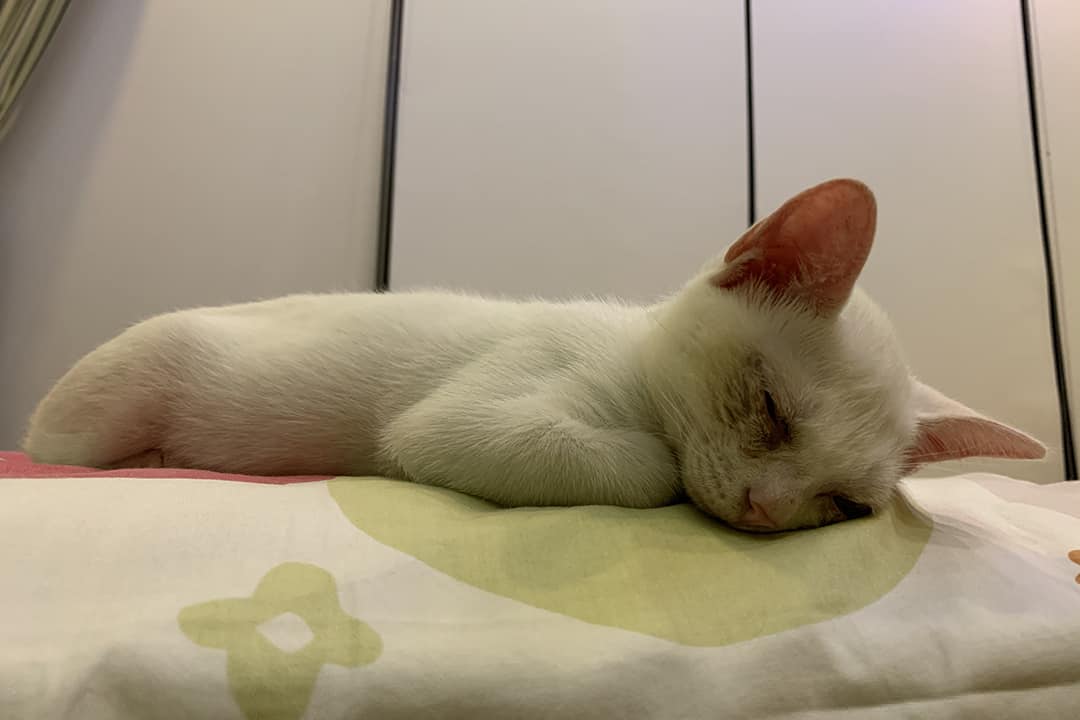When I glanced outside a window from my house in Manila, I saw the usual sight: feral cats of all colours and sizes roaming the single-lane gravel road. As I walked outside, I saw some of them lying under the metal undersides of cars, plopped under the shades of banana trees, and even relaxed on driveways.
I hadn’t given them much thought before the pandemic. Between the chaos of living with the four dogs we have at home and the hubbub of keeping up with my family, friends, and schoolwork, my mind was already filled to the brim with things to care about.
During the pandemic, however, some community members — including my older sister and 10-year-old brother — decided to actively take better care of these feral cats. In the summer of 2021, they bought sacks of dry cat food and boxes of cat milk formula and began to feed the feral cats and kittens.
New beginnings
Two months after they started this makeshift feeding program, they saw her: a kitten so tiny she could fit in the palm of your hand. She was resting under a tree with her eyes closed. My sister and brother fed her some milk, then left to feed the others.
Three days later, they noticed that the kitten’s eyes were still closed, so they decided to bring her to our vet. In the clinic, they discovered that the kitten was only two weeks old and had a potentially fatal eye infection. She was most likely already blind.
These eye infections, which are viral in origin, seem to be common among feral cats. Our vet speculated that the virus that caused the infection was passed down from mother to kitten and was exacerbated by the unclean environment the kitten was born in. They prescribed the kitten four kinds of solutions and syrups. Since the infection could potentially spread systemically to her other organs if left unchecked, she would also need to undergo surgery to have her eyeballs removed.
After that, my siblings brought her to our home. That was when I met her for the first time. I couldn’t believe how small she was — how her tiny body was able to withstand the dust and germs that saturated the streets. Her eyeballs bulged out of their sockets, and they were so cloudy that none of us could see her pupils anymore.
We named her Kitty. Sometimes, we call her Kitty Monster just to joke around with her.
Raising Kitty wasn’t easy. She meowed endlessly for days and kept nibbling at our skin with her tiny teeth. We had to buy a cone to prevent her from scratching her eyes, and to teach her both where and how to pee — but what a joy it was to give some of yourself to someone else and for them to trust you entirely.
The importance of animal welfare
According to the World Organization for Animal Health, animal welfare involves ensuring that an animal is well-nourished, able to express normal behaviours, and not suffering from pain or chronic fear. Many science journals have emphasized the importance of animal welfare by linking it to human issues like maintaining food quality, sustainable food production, and controlling diseases — but I think that animal welfare doesn’t need to serve a functional purpose for humans in order to be considered important.
We strive to treat our fellow humans with respect, not as a means to anything but as an end in and of itself. I think about treating our fellow animals in the same way: because animals have inherent value, animal welfare could be of value for its own sake.
According to philosopher Markus Wild, “Animals don’t just have value for us, but also for themselves.” Animals are also agents that lead their own lives, use their abilities to interact with their surroundings, and experience a myriad of emotions throughout the ups and downs of their existence.
We publish scientific articles in order to prove that non-human animals also feel; we even have a scientific concept termed ‘sentience’ to describe this consciousness. But whenever I press my ear against Kitty’s belly and hear her heart beating, or lie down beside her and hear her snoring, I already know intuitively that there’s no way that this being couldn’t also feel happiness, fear, and love.
Overall, my siblings and I realized that we should do something about the broader feral cat population in our community. We couldn’t possibly feed all of them forever, and attempting to do so would only increase their population. Hopefully, my siblings and I will be able to continue with our plans to conduct a trap-neuter-release program in our community someday, which is what numerous animal welfare organizations suggest is the most humane and effective way to control feral populations.
Through this method, trained professionals humanely capture feral cats and send them to clinics for neutering and vaccination. After the cats recover, these professionals return the cats to their original homes in the outdoors, with their colonies.
I’ve been away from Kitty for six months now, and I can’t wait to see her when I get home to Manila in two weeks’ time. She’s now nine months old, and even though she’s just one feral cat out of countless others, I feel honoured that my family took a chance with her. On top of that, I’m happy that she found a home in us — and that we found a home in her.


